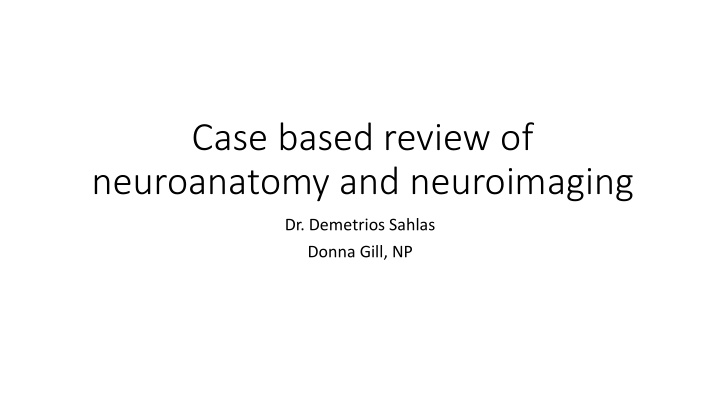



Case based review of neuroanatomy and neuroimaging Dr. Demetrios Sahlas Donna Gill, NP
Objectives 1. Review neuroanatomy and function of the brain 2. Apply understanding of brain function to patients with stroke to appreciate the neurological deficits and stroke etiology 3. Apply understanding of stroke location to radiographic imaging 4. Discuss how location, size and type of stroke affect recovery
Left Brain Function
Right Brain Function
Case #1 - presentation • 33 yo woman presented to ER with decreased LOC, confusion • PMHx - bipolar disorder and substance abuse • Tox screen + for trace amounts – thought to be possible overdose • Neuro exam - dense R hemiplegia and global aphasia • Social Hx – divorced, 3 children, new partner • What do we think her brain imaging will show? • What will our goals and challenges with her be?
Case #2 - presentation • 86 yo lady presented with confusion and slurred speech • PMHx - diabetes, HTN • Neuro exam - L UE numbness, dysarthria, word-finding difficulties • Social situation - Lived alone, was not driving • What do we think the imaging will show? • What will our goals and challenges for her be?
Case # 3 - presentation • 65 yo man presented with sudden left sided weakness • PMHx HTN, dyslipidemia, 40 pack yrs smoking • Social Hx – recently retired, completely independent, single • Neuro exam – dense L hemiplegia, L neglect • What do you think his imaging will show? • What are your goals and challenges?
Case #4 - presentation • 54 yo man presented with left sided weakness • PMHx uncontrolled HTN • Social Hx - working, completely independent, married • Neuro exam – dense L hemiplegia, dysphagia, dysarthria • What do you think his imaging will show?
Case # 5 - presentation • 72 yo man presented with vertigo • PMHx of HTN, diabetes x 20 years • Social Hx – retired, independent, married • Neuro exam – poor balance, ataxia, R ptosis, R myosis, numbness R side of face Horner’s Syndrome and Wallenberg Syndrome • What do you think his imaging will show?
Conclusions • Based on the presenting symptoms you can anticipate the location of the stroke in the brain. Also, based on the known area of stroke you can anticipate what deficits an individual will have. • The extent and severity of stroke deficits are not always related to the size of the stroke. • Stroke recovery is affected by many factors and does not always correlate to the size of stroke.
Recommend
More recommend